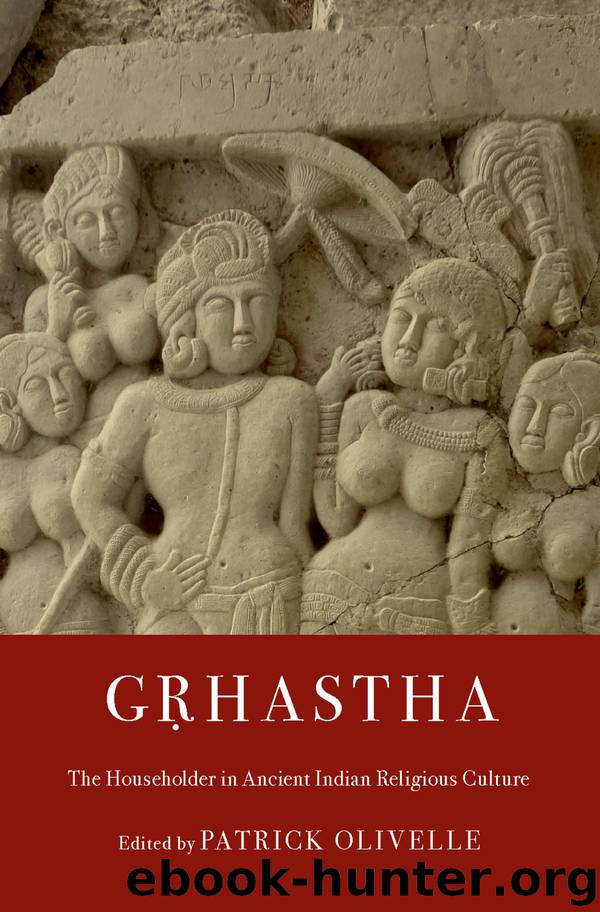G. rhastha by Olivelle Patrick;

Author:Olivelle, Patrick;
Language: eng
Format: epub
Publisher: Oxford University Press
Published: 2019-01-15T00:00:00+00:00
* * *
1. These five great sacrifices are enumerated by Manu (MDh 3.70): “The sacrifice to the Veda is teaching; the sacrifice to ancestors is the quenching libation; the sacrifice to gods is the burnt offering; the sacrifice to beings is the Bali offering; and the sacrifice to humans is the honoring of guests.”
2. For an extensive discussion of the epistemology of dharma, see Olivelle 2017.
3. Although this is a text from the fourth or fifth century ce, I think it reflects a common view of the holiness of a gṛhastha in all Dharmaśāstras.
4. See Kane 1962–75, I: 19–20: “It seems that originally many, though not all, of the dharmasūtras formed part of the Kalpasūtras and were studied in distinct sūtracaraṇas. . . . The Dharmasūtras belonging to all sūtracaraṇas have not come down to us.” Lingat (1973: 10–12), likewise, takes the Dharmasūtras to be compositions within the Vedic schools producing the Kalpasūtras: “Each school of the Veda should have, in addition to its saṃhitā and its brāhmaṇa, its threefold series (at least in theory) of the kalpa-sūtra: śrauta, gṛhya, and dharma.”
5. See Olivelle 2006b, 2009b, and especially 2010.. Some of the ideas presented here are also found in Olivelle 2018.
6. Gautama’s reason for upholding the aikāśramya theory is based on the fact that the āśrama of the gṛhastha is prescribed in explicit or visible Vedic texts, the kind of text referred to in Mīmāṃsā as pratyakṣaśruti. They are Vedic texts that we actually have and can examine are distinguished from the other category anumitaśruti, or Vedic texts whose existence has to be inferred on the basis of texts of recollection (smṛti), which are supposed to be based on the Veda. For theological discussions surround these two categories of Vedic texts, see Olivelle 2017: 31–33, 88–139. Baudhāyana’s defense of the aikāśramya theory is based on the doctrine of the three debts with which a person is born: the debt to seers to be paid by the study of the Vedas, the debt to gods to be paid by offering sacrifices, and the debt to ancestors to be paid by making ancestral offerings. The fact that one marries and can legitimately produce offspring, especially sons, only in the āśrama of the gṛhastha makes it impossible for those in other āśramas to pay the debts to the gods (a wife is required to perform Vedic sacrifices) and to the ancestors (sons are required to continue the line and to make future ancestral offerings). See Olivelle 1993: 46–53.
7. See Patañjali’s comment (on Pāṇini 4.1.33), cited above.
8. At this point, I am not confident enough to assert that this theology came from the gṛhastha members of the Brahmanical pāṣaṇḍa, or to speculate whether there were theological disputes between the gṛhastha and pravrajita demographics within it.
9. For a similar statement, see MDh 6.87–90.
10. The exact meaning and reference of the last two verses are not altogether clear. I think the first of the two with its reference to “ending up” (yānti saṃstitim) perhaps refers to the old doctrine of the five fires.
Download
This site does not store any files on its server. We only index and link to content provided by other sites. Please contact the content providers to delete copyright contents if any and email us, we'll remove relevant links or contents immediately.
| Africa | Americas |
| Arctic & Antarctica | Asia |
| Australia & Oceania | Europe |
| Middle East | Russia |
| United States | World |
| Ancient Civilizations | Military |
| Historical Study & Educational Resources |
The Sympathizer by Viet Thanh Nguyen(4091)
The Rape of Nanking by Iris Chang(4020)
World without end by Ken Follett(3339)
Ants Among Elephants by Sujatha Gidla(3278)
Blood and Sand by Alex Von Tunzelmann(3055)
Japanese Design by Patricia J. Graham(2997)
City of Djinns: a year in Delhi by William Dalrymple(2430)
Foreign Devils on the Silk Road: The Search for the Lost Treasures of Central Asia by Peter Hopkirk(2385)
Inglorious Empire by Shashi Tharoor(2345)
The Queen of Nothing by Holly Black(2308)
In Order to Live: A North Korean Girl's Journey to Freedom by Yeonmi Park(2301)
India's Ancient Past by R.S. Sharma(2293)
Tokyo by Rob Goss(2286)
India's biggest cover-up by Dhar Anuj(2242)
Tokyo Geek's Guide: Manga, Anime, Gaming, Cosplay, Toys, Idols & More - The Ultimate Guide to Japan's Otaku Culture by Simone Gianni(2235)
The Great Game: On Secret Service in High Asia by Peter Hopkirk(2227)
Goodbye Madame Butterfly(2162)
Batik by Rudolf Smend(2006)
Living Silence in Burma by Christina Fink(1977)
